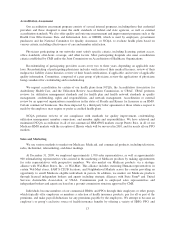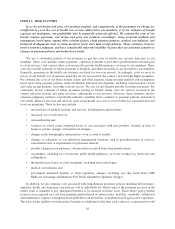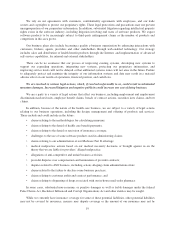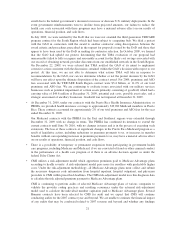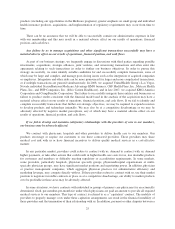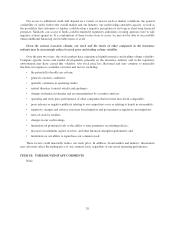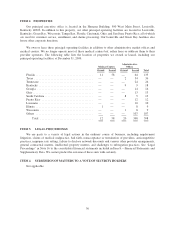Humana 2009 Annual Report Download - page 30
Download and view the complete annual report
Please find page 30 of the 2009 Humana annual report below. You can navigate through the pages in the report by either clicking on the pages listed below, or by using the keyword search tool below to find specific information within the annual report.enough to cover the damages awarded. Additionally, the cost of business insurance coverage has increased
significantly. As a result, we have increased the amount of risk that we self-insure, particularly with respect to
matters incidental to our business. In addition, some types of damages, like punitive damages, may not be
covered by insurance. In some jurisdictions, coverage of punitive damages is prohibited. Insurance coverage for
all or some forms of liability may become unavailable or prohibitively expensive in the future.
The health benefits industry continues to receive significant negative publicity reflecting the public
perception of the industry. This publicity and perception have been accompanied by increased litigation,
including some large jury awards, legislative activity, regulation, and governmental review of industry practices.
These factors may adversely affect our ability to market our products or services, may require us to change our
products or services, may increase the regulatory burdens under which we operate, and may require us to pay
large judgments or fines. Any combination of these factors could further increase our cost of doing business and
adversely affect our results of operations, financial position, and cash flows.
See “Legal Proceedings” in Note 16 to the consolidated financial statements included in Item 8. – Financial
Statements and Supplementary Data. We cannot predict the outcome of these suits with certainty.
Our business activities are subject to substantial government regulation. New laws or regulations, or
changes in existing laws or regulations or their manner of application, could increase our cost of doing
business and may adversely affect our business, profitability and financial condition. In addition, as a
government contractor, we are exposed to additional risks that may adversely affect our business or our
willingness to participate in government health care programs.
A significant portion of our revenues relates to federal and state government health care coverage programs,
including the Medicare, Military, and Medicaid programs. Our Government segment accounted for
approximately 75% of our total premiums and ASO fees for the year ended December 31, 2009. These programs
involve various risks, as described further below.
• At December 31, 2009, under our contracts with CMS we provided health insurance coverage to
approximately 377,900 Medicare Advantage members in Florida. These contracts accounted for
approximately 17% of our total premiums and ASO fees for the year ended December 31, 2009. The
loss of these and other CMS contracts or significant changes in the Medicare program as a result of
legislative or regulatory action, including reductions in premium payments to us, or increases in member
benefits without corresponding increases in premium payments to us, may have a material adverse effect
on our results of operations, financial position, and cash flows.
• At December 31, 2009, our military services business, which accounted for approximately 12% of our
total premiums and ASO fees for the year ended December 31, 2009, primarily consisted of the
TRICARE South Region contract which covers approximately 3.0 million beneficiaries. The original
5-year South Region contract expired March 31, 2009. Through an Amendment of Solicitation/
Modification of Contract to the TRICARE South Region contract, an additional one-year option period,
the sixth option period, which runs from April 1, 2009 through March 31, 2010, was exercised by the
government. The Amendment also provides for two additional six-month option periods: the seventh
option period runs from April 1, 2010 through September 30, 2010 and the eighth option period runs
from October 1, 2010 through March 31, 2011. Exercise of each of the seventh and eighth option
periods is at the government’s option. On December 16, 2009, we were notified by TMA that it intends
to exercise its options to extend the TRICARE South Region contract for Option Period VII and Option
Period VIII. The exercise of these option periods would effectively extend the TRICARE South Region
contract through March 31, 2011. As required under the current contract, the target underwritten health
care cost and underwriting fee amounts for each option period are negotiated. Any variance from the
target health care cost is shared with the federal government. Accordingly, events and circumstances not
contemplated in the negotiated target health care cost amount may have a material adverse effect on us.
These changes may include an increase or reduction in the number of persons enrolled or eligible to
20





